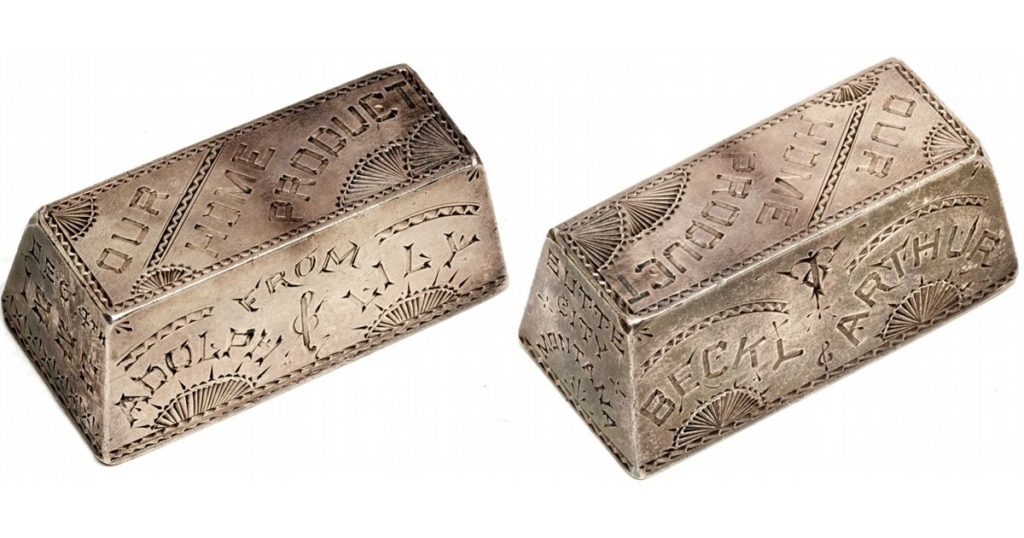7.15 oz Adolph & Lily Silver Ingot MT – Butte,Silver Bow County – 1889
A Butte, Montana Silver Ingot, 1889
A new discovery

The ingot is ornately engraved with floral patterns and engraved from one couple to another, dated December 4, 1889. “Our Home Produce/ Adolph & Lily/ Butte City, MT/ Becky & Arthur/ Dec. 4, 1884” The piece measures 2″ long, 1″ wide, by 0.75″ tall and weighs 7.15 troy ounces. No fineness is stated on the ingot, which has the appearance of a high fineness of silver. At the time, silver was the “home produce” of the Butte mines.
The mining camp of Butte City quickly grew from a small encampment along the Silver Bow creek. Placer gold had been discovered there and was steadily mined from 1864-1867. A few scattered quartz locations were located during that time, but little was done to prospect and further exploit these new mineral locations until after 1867, when it was discovered that the veins held silver, not gold, and that they were thus actually worth something. Miners and prospectors soon learned over the next decade that the Butte lodes carried rich silver, and with depth, came copper. By 1889 when this ingot was made, silver was the chief bullion product of Butte. There were a reported 4000 mining claims staked, of which 1457 had already been patented, according to Burchard in the Report of the Director of the Mint in 1885. The bullion product of Butte in 1889 was $450,150 in gold and $5,793,850 in silver (equivalent to 280,000 ounces of gold – major production at the time.)
The mines of Butte drew the attention of two major financiers and mining men. William Andrews Clark (personal archive now at UCLA) and Marcus Daly competed for the best mines. Clark had been a miner who came to the placer diggings in the 1860’s, done well, and reinvested in local mining ventures. Daly was a miner from the Comstock, with ties to some of the strongest mining men in the world- George Hearst, J.B. A. Haggin and Lloyd Tevis. Daly convinced the trio to back him, and together, the group turned into one of the largest mining companies in the world, though it was later, called The Anaconda Company. Clark used conventional mining methodology and management. Daly became a champion of large tonnage, low grade underground mining at a critical time. Copper was about to explode on the world market, as its use for piping in water systems created a huge demand across America, and then the big explosion that took place in conjunction with the development of municipal electric systems and companies. As America electrified itself, the need for copper exploded beyond anything anyone had ever seen in the world to that point. Daly and Clark were at the forefront.
In 1884, the largest mines were the Alice and the Magna Charta, two mines separated by a single claim between them, located along a vein system 40-80 feet wide, with a shaft 800 feet deep and producing levels to 700’. That year the Butte output was $1.2 to $1.3 million in silver-gold bullion, with almost $1.1 million in silver. Clark’s big mine, the Original, was the largest dividend payer. Daly’s big mines were the Anaconda and Parrott, which by that time were pouring out copper with a byproduct of silver that ran $10-30 per ton. The prior year (1883) Daly had sent 24,320 tons of high grade ore to a mill/smelter in Swansea, Wales which netted a profit of $1.7 million, according to Minar Shoebotham in Anaconda, Life of Marcus Daly (1956). Haggin cut Daly a bonus of $100,000 – millions, by today’s standards.
Butte went on to produce through 1998- 720,176,800 troy ounces of silver (22,400 metric tons) and 21,605,080,000 pounds of copper (9,800,000 metric tons) ranking it as the second largest producing mining district in the United States in both silver and copper, behind only Couer D’Alene, Idaho for silver and Bingham, Utah for copper. The silver production alone is about 2.5 times greater than the Comstock Lode. [Ref: Long et al; Data Base of Significant Deposits of Gold, Silver, Copper, Lead, Zinc in the United States; 1998, USGS Open File Report OF R 98-206A.]
While we cannot identify the people commemorated on the ingot, it remains a great artifact of the Butte silver mines from the period just before the copper explosion.
[08/2012] https://www.icollector.com/Adolph-Lily-Silver-Ingot-MT-Butte-Silver-Bow-County-1884-2012aug-Numismatic_i13391239 ($14,340)
